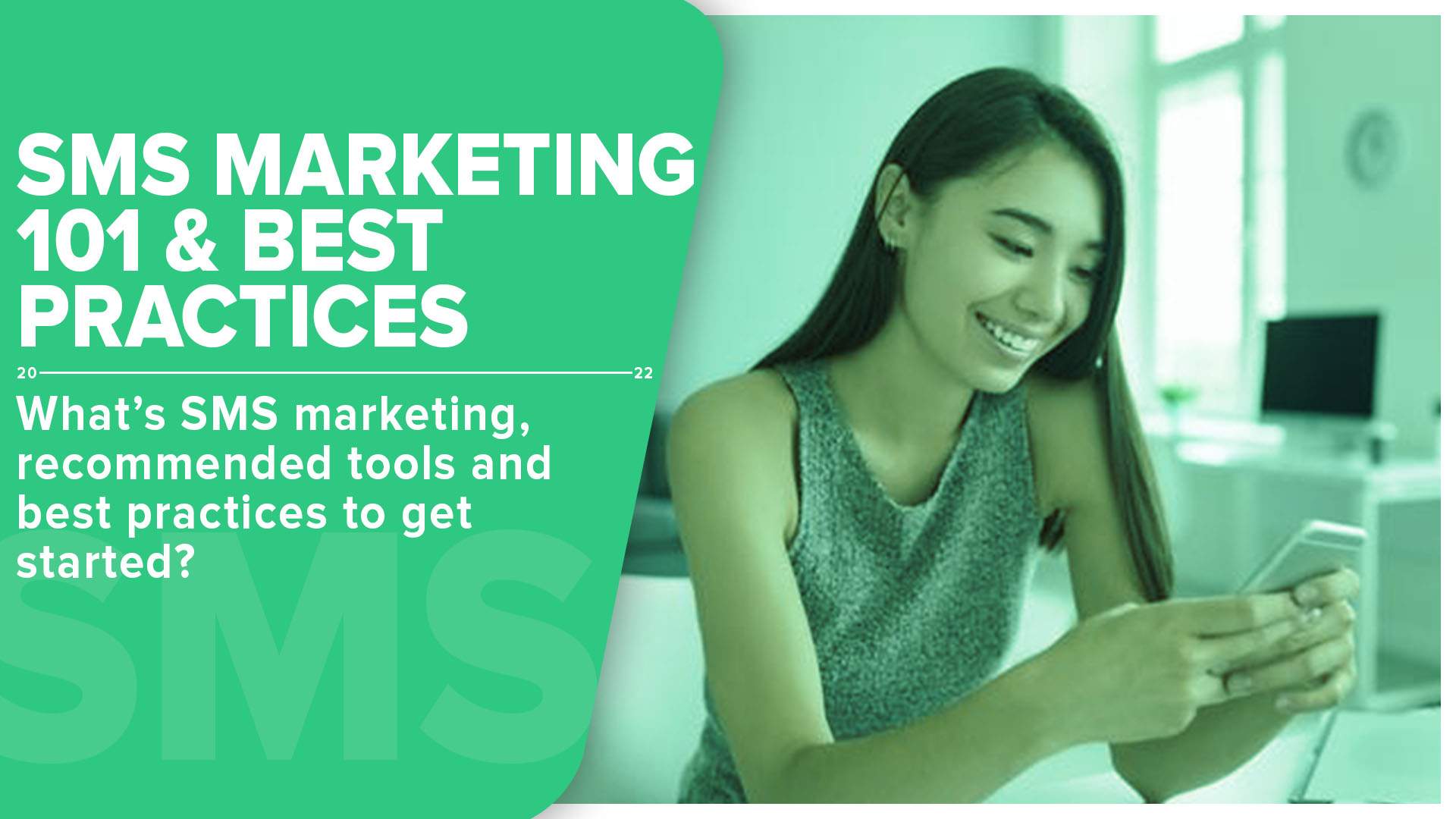
Are you looking for a way to take your marketing efforts to the next level? If so, consider SMS marketing. With over 1.6 billion active mobile phone users worldwide, SMS marketing is one of the most popular and effective ways to reach your target audience. Plus, it’s a great way to stay top-of-mind with your customers and prospects.
It allows you to reach a large audience with minimal effort and is an incredibly powerful tool for building customer relationships. Still, trying to figure out where to start? Don’t worry; we’re here to help. This blog post will give you an overview of SMS marketing and share some best practices for getting started. So let’s get started!
Basics of SMS Marketing
What is SMS Marketing?
SMS marketing is a form of marketing that uses text messages to promote products, services, or brands. While traditional marketing relies on mediums like television, radio, and print ads, SMS marketing allows businesses to reach customers directly on their mobile phones. Using SMS marketing techniques, businesses can send coupons, discounts, and special offers, promote sales and events, or simply remind customers about a product or service.
When done correctly, SMS marketing is a powerful marketing tactic that can help companies achieve their goals. Since customers opt-in to receive SMS messages from businesses, they are more likely to be receptive. Let text messages have a high open rate (approximately 98%) and response rate
Benefits of SMS Marketing
Increased Engagement
SMS marketing can be a highly effective way to increase customer engagement. The key is to send carefully targeted messages that offer value to the recipient. For example, a business could send a reminder about an upcoming sale or a special offer for loyalty program members. By providing recipients with relevant information, companies can encourage them to interact more frequently with the brand.
In addition, SMS marketing can be used to collect feedback from customers and gauge their level of satisfaction with recent purchases. Businesses can make necessary adjustments to improve the customer experience by gathering this feedback. Ultimately, SMS marketing can help companies build deeper relationships with their customers and encourage them to remain loyal.
Higher ROI
With SMS marketing, businesses can reach a wide audience with little effort. It takes a few clicks to set up a campaign and send messages, provided you have invested the time and effort into building a list. And because SMS marketing is so effective, it doesn’t take long to start seeing results. With a higher ROI, businesses can re-invest those funds into other areas to continue growing.
Furthermore, SMS marketing is highly personalized. With this type of marketing, businesses can send targeted messages to specific groups of people. This ensures that everyone who receives a text message is interested in what you have to say. As a result, they’re more likely to act on your message, which leads to increased ROI.
Finally, SMS marketing is trackable. Businesses may monitor how many people received, opened, and clicked on the link in their message. This data is essential for understanding what’s working and what isn’t. With this information, businesses can tweak their strategies and ensure they always get the most out of their campaigns.
The Best SMS Marketing Practices
1. Keep your messages brief and to the point
In the world of SMS marketing, conciseness is key. Your subscribers will likely need more time or patience to read through a lengthy message, no matter how well-written it may be. Instead, they’ll appreciate a clear, concise message that gets straight to the point.
Brevity also allows you to include more content in your campaign, which can be especially important if you’re running a contest or promoting a limited-time offer. A good rule of thumb is to keep your message between 130-150 characters and end with writing a compelling CTA.
Perhaps most importantly, keeping your messages brief and to the point ensures that your subscribers will read them. After all, there’s no point in sending out a great message if no one bothered to read it in the first place. So next time you’re crafting an SMS campaign, remember: less is more.
2. Timing is everything
Timing is everything when it comes to SMS marketing best practices. Sending your messages at the right time can make all the difference in whether or not they are read and acted upon. For example, a message sent during the workday is more likely to be seen as a disturbance than one sent after work hours.
Similarly, a message sent on a Monday is more likely to be forgotten than one sent on a Friday. By taking the time to consider when your target audience is most likely to be available, you can ensure that your messages have maximum impact.
3. Use images and emojis to add visual interest
One of the best ways to add visual interest to your SMS marketing campaigns is to use images and emojis. By using eye-catching visuals, you can capture the attention of your target audience and encourage them to read your message. Images and emojis can also help to convey a message more effectively than text alone.
For example, an emoji can express an emotion or add a touch of humor, while an image can provide additional information about your product or service. When used correctly, images and emojis can drive engagement and boost conversions.
4. Personalize your messages for each recipient
When it comes to SMS marketing, personalizing your messages for each recipient is one of the best practices you can follow. Why? Because people like to feel like they matter and that you care about them. When you take the time to personalize your messages, it shows that you value your customers and are willing to go the extra mile to communicate with them.
For example, let’s say you own a clothing store and are promoting new arrivals. If you simply sent out a mass text saying, “Hey, check out our new arrivals!” you wouldn’t get much of a response. But if you took the time to look through your contact list and saw that one of your regular customers has been eyeing a specific dress for a while, you could send her a text that says something like “Hey [customer’s name], we just got a new shipment of dresses in, and I know you’ve been looking for that red one! Come by today, and we’ll give you 10% off!” Now that’s a message she’s sure to respond to.
The bottom line is that personalizing your SMS messages shows that you care about your customers and are willing to invest the time in communicating with them personally. This will surely result in more engagement and conversions from your marketing campaigns.
5. Use a personal tone
Using a personal tone in your SMS marketing is one of the best practices you can follow. By being friendly and engaging, you create a rapport with potential and current customers, encouraging them to do business with you. Here are some ways that using a personal tone can benefit your SMS marketing campaign:
- It builds trust. Customers are more likely to do business with someone they trust, and using a personal tone helps to build that trust.
- It makes your message more memorable. If your customers enjoy reading your SMS messages, they will remember your brand when they need your product or service.
- It sets you apart from the competition. With so many businesses competing for attention, finding ways to stand out is important. Using a personal tone in your marketing can help you do just that.
By using a personal tone in your SMS marketing, you can reap all of these benefits and more. So don’t be afraid to let your personality shine through in your messages – it might be the key to success.
6. Make sure your offer is clear and enticing
Regarding SMS marketing, one of the most important practices is ensuring your offer is clear and enticing. After all, you want people to take action when they receive your message. So how can you make sure your offer is up to par? Here are a few things to keep in mind:
First, your offer should be relevant to your target audience. It should be something that they would be interested in taking advantage of. For example, if you’re targeting parents, a free childcare consultation offer would be much more relevant than a free car detail offer.
Second, your offer should be clear and easy to understand. There’s nothing worse than receiving an SMS with an offer that’s confusing or ambiguous. Make sure your message is concise and straight to the point.
Lastly, your offer should be enticing. In other words, it should be something people want to take advantage of. A great way to do this is to include a special incentive, such as a discount or limited-time offer.
7. Test, test, test
There’s no denying that SMS marketing is one of the most powerful tools in a marketer’s toolkit. But, like with any tool, it’s only as effective as the person using it.
One of the best ways to ensure your SMS marketing campaigns are effective is always to test, test, test. You can have the most amazing offer in the world, but if your messaging falls flat, you won’t get any results. That’s why it’s essential to constantly test different approaches and see what works best for your audience. You may find that shorter messages are more effective than longer ones. Or perhaps you may discover that including a call-to-action gets better results. A personal touch goes a long way, or a sense of urgency drives more conversions.
The only way to know what works is to experiment. So don’t be afraid to try something new with your next SMS campaign. You might just be surprised at the results.
Top 3 Tools for SMS Marketing
1. Klaviyo
Klaviyo is a top tool for SMS marketing because it allows you to tap into your customer’s preferences and send them tailored messages that they’re interested in. With Klaviyo, you can send welcome offers, new product announcements, coupons and sales, back-in-stock alerts, order confirmations, purchase follow-ups, and more – all through the channel that your customers prefer.
And because Klaviyo texting is a two-way street, customers will be delighted when they text you back and receive a human response! With built-in contact cards, you’ll also come across as friendly and approachable – not some random unknown number. So if you’re looking for a creative and effective way to reach your customers, Klaviyo is the perfect solution.
2. Postscript
Because it can segment and customize messages at scale, Postscript is the ideal tool for SMS marketing. You can increase traffic and revenue by targeting particular groupings of subscribers based on their location, engagement, behavior, and past purchases using Postscript’s extensive menu of filters and tags.
Additionally, you can make sure that every customer receives the appropriate communication at the appropriate moment by using Postscript’s automated triggered responses, which include welcome series, abandoned carts, shipping alerts, and cross-sell promotions. You can boost conversions with pertinent, timely promotions by integrating hyper-targeted customer segments and data from your Shopify store. So put down that email blast — with Postscript, SMS is where it’s at!
3. Emotive
At Emotive, they understand that SMS marketing is a powerful tool — but only when used correctly. That’s why they’ve designed their software to build customer interactions that seamlessly convert into sales. This helps you build sustainable customer relations, increase conversion, and enhance your brand’s voice.
With Emotive, it’s easy to convert traffic into subscriptions. And because it’s compliant with all the necessary regulations (TCPA, CCPA, CTIA), you can rest assured that you always operate within the law. This software makes it easy to segment your audience and see campaign performance at a glance. So if you’re looking for a top-quality SMS marketing tool, look no further than Emotive!
Conclusion
Now that you know the ins and outs of SMS marketing, it’s time to start! The best way to see if SMS marketing will work for your brand is to try it out. Start by crafting promotional messages and sending them to a small group of customers. Monitor your results and adjust accordingly. Remember always to keep your messaging personal, relevant and valuable. And last but not least, don’t forget to measure your ROI so you can continue to optimize your strategy over time.
Some of the best practices for SMS marketing include keeping your message concise and timing it right. You should also employ emojis and images to build a positive brand image, and connect with your customers on a personal level. Plus, personalization is the key when it comes to SMS marketing, so make sure that you take the time to curate personalized texts for your recipients. Lastly, be sure to come up with an enticing offer, and don’t forget to test your campaigns.
When it comes to choosing an SMS marketing platform, there are a few great options out there. Klaviyo, Postscript, and Emotive are all great choices that offer different features depending on your preferences. So take some time to research each before settling on the right tool. Now go forth and start conquering the world of SMS marketing!




